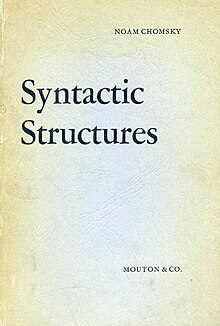
Back بنى نحوية Arabic সিন্ট্যাকটিক স্ট্রাকচারস Bengali/Bangla Estructures sintàctiques Catalan Syntaktické struktury Czech Estructuras sintácticas Spanish ساختهای نحوی Persian Noam Chomsky#Linguistique French מבנים תחביריים HE Շարահյուսական կառույցներ Armenian Синтаксистік құрылым Kazakh
 First edition cover | |
| Author | Noam Chomsky |
|---|---|
| Language | English |
| Subject | Natural language syntax |
| Publisher | Mouton & Co. |
Publication date | February 1957 |
| Media type | |
| Pages | 117 |
| Preceded by | The Logical Structure of Linguistic Theory (unpublished mimeographed or microfilm version) |
| Followed by | Aspects of the Theory of Syntax |
Syntactic Structures is an important work in linguistics by American linguist Noam Chomsky, originally published in 1957. A short monograph of about a hundred pages, it is recognized as one of the most significant and influential linguistic studies of the 20th century.[1][2] It contains the now-famous sentence "Colorless green ideas sleep furiously",[3] which Chomsky offered as an example of a grammatically correct sentence that has no discernible meaning, thus arguing for the independence of syntax (the study of sentence structures) from semantics (the study of meaning).[4][note 1]
Based on lecture notes he had prepared for his students at the Massachusetts Institute of Technology in the mid-1950s,[note 2] Syntactic Structures was Chomsky's first book on linguistics and reflected the contemporary developments in early generative grammar. In it, Chomsky introduced his idea of a transformational generative grammar, succinctly synthesizing and integrating the concepts of transformation (pioneered by his mentor Zellig Harris, but used in a precise and integrative way by Chomsky), morphophonemic rules (introduced by Leonard Bloomfield) and an item-and-process style of grammar description (developed by Charles Hockett).[5][6][7] Here, Chomsky's approach to syntax is fully formal (based on symbols and rules). At its base, Chomsky uses phrase structure rules,[note 3] which break down sentences into smaller parts. These are combined with a new kind of rules which Chomsky called "transformations". This procedure gives rise to different sentence structures.[8] Chomsky stated that this limited set of rules "generates"[9][note 4] all and only the grammatical sentences of a given language, which are infinite in number (not too dissimilar to a notion introduced earlier by Danish linguist Louis Hjelmslev[5]).[10][11] Although not explicitly stated in the book itself, this way of study was later interpreted to have valued language's innate place in the mind over language as learned behavior,[note 5][12][note 6][13]
Written when Chomsky was still an unknown scholar,[note 7] Syntactic Structures had a major impact on the study of knowledge, mind and mental processes, becoming an influential work in the formation of the field of cognitive science.[14] It also significantly influenced research on computers and the brain.[note 8] The importance of Syntactic Structures lies in Chomsky's persuasion for a biological perspective on language at a time when it was unusual, and in the context of formal linguistics where it was unexpected.[12][dubious ] The book led to Chomsky's eventual recognition as one of the founders of what is now known as sociobiology.[15][16] Some specialists have questioned Chomsky's theory, believing it is wrong to describe language as an ideal system. They also say it gives less value to the gathering and testing of data.[note 9] Nevertheless, Syntactic Structures is credited to have changed the course of linguistics in general and American linguistics in particular in the second half of the 20th century.
- ^ Cook 2007
- ^ Cite error: The named reference
timemagwas invoked but never defined (see the help page). - ^ Cite error: The named reference
Chomskywas invoked but never defined (see the help page). - ^ Chomsky 1957, p. 17
- ^ a b Seuren, Pieter A. M. (1998). Western linguistics: An historical introduction. Wiley-Blackwell. pp. 250–251. ISBN 0-631-20891-7.
- ^ Joseph 2002, p. [page needed].
- ^ Tomalin 2006, p. [page needed].
- ^ Chomsky 1957, p. 44
- ^ Cite error: The named reference
sswas invoked but never defined (see the help page). - ^ Cite error: The named reference
Chomsky 1957: 49was invoked but never defined (see the help page). - ^ Chomsky 1957, p. 85
- ^ a b Lightfoot, David W. (2002). "Introduction to the second edition of Syntactic Structures by Noam Chomsky". In Lightfoot, David W. (ed.). Syntactic Structures (second ed.). Berlin: Mouton de Gruyter. pp. v–xviii. ISBN 3110172798. Retrieved 2020-02-26.
- ^ Hjelmslev, Louis (1969) [First published 1943]. Prolegomena to a Theory of Language. University of Wisconsin Press. ISBN 0299024709.
- ^ "The Cognitive Science Millennium Project". 2004-08-21. Archived from the original on 2004-08-21. Retrieved 2019-12-31.
- ^ Anthropology, Radical (2008). "Human nature and the origins of language" (PDF). Radical Anthropology (2). Retrieved 2020-02-25.
- ^ Johnson, Steven (2002). "Sociobiology and you". The Nation (November 18). Retrieved 2020-02-25.
Cite error: There are <ref group=note> tags on this page, but the references will not show without a {{reflist|group=note}} template (see the help page).
© MMXXIII Rich X Search. We shall prevail. All rights reserved. Rich X Search